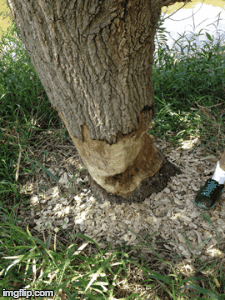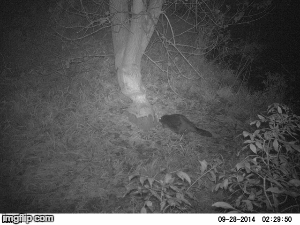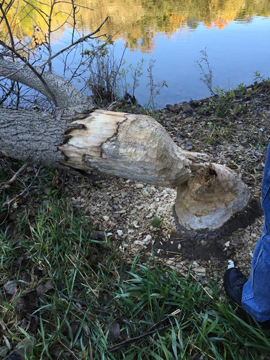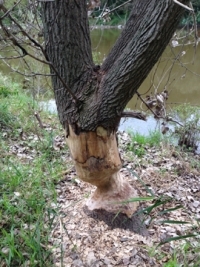
The Center's Research & Community Science Team’s mammal monitoring program was first piloted in 2006 and now uses visual surveys, live trapping and camera surveillance to create an inclusive species list for the three parks we manage. Sherman folding live traps and wildlife camera surveillance help document nocturnal and elusive species. Our greatest effort for camera surveillance is in the Milwaukee Rotary Centennial Arboretum (Riverside Park).
The beaver is known to be a diurnal herbivore, eating the bark, leaves and twigs of a variety of trees. Cottonwoods are one of its favorite tree flavors. After Jennifer found evidence of beaver chew, we placed a wildlife camera in the vicinity, focused directly on one of the Cottonwood trees with chew marks. Our first run of three days of camera surveillance showed nothing but squirrels and people walking their dogs. After replacing the camera on Thursday, September 25th, we let it run for the next 12 days. Staff and volunteers visited the tree during that time and reported fresh chew marks. On Tuesday, October 7th, we retrieved the camera to review the results. And, indeed, the wildlife camera captured the busy beaver!
After reviewing over a thousand images from the 12-day camera surveillance period, we identified active periods on 5 days.

Surprisingly, we did not see the beaver during the daylight hours. The beaver was captured busily chewing away in the early morning or late evening. Perhaps the urban setting has influenced this animal’s behavior. There were 54 images of the beaver. Active periods are below:
Sunday (9/28)
- 2:29-2:33 am
Saturday (10/4)
- 3:03 am - 3:17am
- 4:23 am - 4:30 am
- 4:40 am - 4:48 am
- 5:38 am - 5:41 am
- 9:45 pm - 9:46 pm
- 11:11 pm
Sunday (10/5)
- 1:06 am – 1:07 am
- 1:20 am – 1:24 am
- 9:26 pm – 9:33 pm
Monday (10/6)
- 4:13 am – 4:39 am
- 8:29 pm – 8:30 pm
Tuesday (10/7)
- 1:49 am – 2:01 am
- 2:59 am – 3:01 am
Additional Species captured by the camera included:
- Eastern Gray Squirrel (10 images)
- Domestic Dog (22 images)
- Feral Cat (11 images)

- Raccoon (8 images)
- Great Blue Heron (1 image)
On Wednesday (10/8) our resident beaver finally felled the large cottonwood. Unfortunately, we hadn’t had time to replace the camera so we missed the “Timber!” moment. We do have a shot from the day after, taken by Jennifer while on the weekly bird walk.
Fun Facts
- Beavers are monogamous! They mate for life-underwater and during the winter! Babies are born in late spring or early summer.
- In addition to trees, beavers also eat aquatic and semiaquatic plants like the roots of water lilies.
- Much of the beaver’s food is stored underwater in their lodge to protect it from freezing during cold winter months.
- Beavers are the penultimate landscape changer, second only to humans. Some evidence of their work in Canada can be seen on satellite imagery.
- Did you know beaver teeth never stop growing? Beavers are part of the rodent family, in which tooth growth is indeterminate.
Want to learn more about the Center's research efforts? Connect with our Community Science team to learn more!




